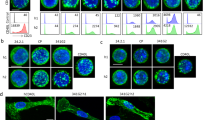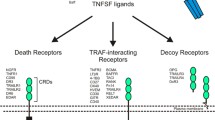Abstract
LIGHT is a member of the tumor necrosis factor ligand superfamily, which plays important roles in inflammatory and immune responses. LIGHT forms a membrane-anchored homotrimeric complex on the cell surface and is often processed as a soluble protein. Recombinant soluble human LIGHT produced by mammalian cells or Escherichia coli is functional at nanomolar concentrations. However, there is little information about the biological activity of mouse LIGHT (mLIGHT) because of the difficulty in producing bioactive soluble mLIGHT. In this study, recombinant trimeric soluble mLIGHT, or Foldon-mLIGHT, was produced by fusing mLIGHT with the trimerization domain foldon from bacteriophage T4 fibritin. Foldon-mLIGHT was secreted from 293F cells as a 68-kDa trimeric protein. The recombinant protein potently inhibited the growth of the FM3A mouse mammary carcinoma cell line with an IC50 of 77 pM; however, the monomer or dimer forms of mLIGHT produced by E. coli or mammalian cell systems showed weak or no inhibitory activity. These data clearly indicated that trimerization of soluble mLIGHT is essential for its biological activity.





Similar content being viewed by others
References
Altinoz MA, Bilir A, Gedikoglu G, Ozcan E, Oktem G, Muslumanoglu M (2007) Medroxyprogesterone and tamoxifen augment anti-proliferative efficacy and reduce mitochondria-toxicity of epirubicin in FM3A tumor cells in vitro. Cell Biol Int 31:473–481
Berg D, Lehne M, Müller N, Siegmund D, Münkel S, Sebald W, Pfizenmaier K, Wajant H (2007) Enforced covalent trimerization increases the activity of the TNF ligand family members TRAIL and CD95L. Cell Death Differ 14:2021–2034
Bossen C, Ingold K, Tardivel A, Bodmer JL, Gaide O, Hertig S, Ambrose C, Tschopp J, Schneider P (2006) Interactions of tumor necrosis factor (TNF) and TNF receptor family members in the mouse and human. J Biol Chem 281:13964–13971
Browning JL, Sizing ID, Lawton P, Bourdon PR, Rennert PD, Majeau GR, Ambrose CM, Hession C, Miatkowski K, Griffiths DA, Ngam-ek A, Meier W, Benjamin CD, Hochman PS (1997) Characterization of lymphotoxin-alpha beta complexes on the surface of mouse lymphocytes. J Immunol 159:3288–3298
Chen MC, Hwang MJ, Chou YC, Chen WH, Cheng G, Nakano H, Luh TY, Mai SC, Hsieh SL (2003) The role of apoptosis signal-regulating kinase 1 in lymphotoxin-beta receptor-mediated cell death. J Biol Chem 278:16073–16081
Granger SW, Butrovich KD, Houshmand P, Edwards WR, Ware CF (2001) Genomic characterization of LIGHT reveals linkage to an immune response locus on chromosome 19p13.3 and distinct isoforms generated by alternate splicing or proteolysis. J Immunol 167:5122–5128
Frank S, Kammerer RA, Mechling D, Schulthess T, Landwehr R, Bann J, Guo Y, Lustig A, Bachinger HP, Engel J (2001) Stabilization of short collagen-like triple helices by protein engineering. J Mol Biol 308:1081–1089
Harrop JA, McDonnell PC, Brigham-Burke M, Lyn SD, Minton J, Tan KB, Dede K, Spampanato J, Silverman C, Hensley P, DiPrinzio R, Emery JG, Deen K, Eichman C, Chabot-Fletcher M, Truneh A, Young PR (1998) Herpesvirus entry mediator ligand (HVEM-L), a novel ligand for HVEM/TR2, stimulates proliferation of T cells and inhibits HT29 cell growth. J Biol Chem 273:27548–27556
Hikichi Y, Matsui H, Tsuji I, Nishi K, Yamada T, Shintani Y, Onda H (2001) LIGHT, a member of the TNF superfamily, induces morphological changes and delays proliferation in the human rhabdomyosarcoma cell line RD. Biochem Biophys Res Commun 289:670–677
Itoh T, Kondo M, Tanaka Y, Kobayashi M, Sasada R, Igarashi K, Suenaga M, Koyama N, Nishimura O, Fujino M (2001) Novel betacellulin derivatives. Separation of the differentiation activity from the mitogenic activity. J Biol Chem 276:40698–40703
Letarov AV, Londer YY, Boudko SP, Mesyanzhinov VV (1999) The carboxy-terminal domain initiates trimerization of bacteriophage T4 fibritin. Biochemistry (Moscow) 64:817–823
Matsui H, Hikichi Y, Tsuji I, Yamada T, Shintani Y (2002) LIGHT, a member of the tumor necrosis factor ligand superfamily, prevents tumor necrosis factor-α-mediated human primary hepatocyte apoptosis, but not Fas-mediated apoptosis. J Biol Chem 277:50054–50061
Mauri DN, Ebner R, Montgomer RI, Kochel KD, Cheung TC, Yu GL, Ruben S, Murphy M, Eisenberg RJ, Cohen GH, Spear PG, Ware CF (1998) LIGHT, a new member of the TNF superfamily, and lymphotoxin alpha are ligands for herpesvirus entry mediator. Immunity 8:21–30
Meier S, Guthe S, Kiefhaber T, Grzesiek S (2004) Foldon, the natural trimerization domain of T4 fibritin, dissociates into a monomeric A-state form containing a stable beta-hairpin: atomic details of trimer dissociation and local beta-hairpin stability from residual dipolar couplings. J Mol Biol 344:1051–1069
Morel Y, Truneh A, Sweet RW, Olive D, Costello RT (2001) The TNF superfamily members LIGHT and CD154 (CD40 ligand) costimulate induction of dendritic cell maturation and elicit specific CTL activity. J Immunol 167:2479–2486
Rooney IA, Butrovich KD, Glass AA, Borboroglu S, Benedict CA, Whitbeck JC, Cohen GH, Eisenberg RJ, Ware CF (2000) The lymphotoxin-β receptor is necessary and sufficient for LIGHT-mediated apoptosis of tumor cells. J Biol Chem 275:14307–14315
Sato A, Satake A, Hiramoto A, Miyazaki E, Okamatsu A, Nakama K, Hiraoka O, Miyake T, Kim HS, Wataya Y (2008) Molecular mechanisms in two cell death-types, necrosis and apoptosis, induced by 5-fluoro-2′-deoxyuridine. Nucleic Acids Symp Ser (Oxf) 52:627–628
Shaikh RB, Santee S, Granger SW, Butrovich K, Cheung T, Kronenberg M, Cheroutre H, Ware CF (2001) Constitutive expression of LIGHT on T cells leads to lymphocyte activation, inflammation, and tissue destruction. J Immunol 167:6330–6337
Tamada K, Shimozaki K, Chapoval AI, Zhai Y, Su J, Chen SF, Hsieh SL, Nagata S, Ni J, Chen L (2000a) LIGHT, a TNF-like molecule, costimulates T cell proliferation and is required for dendritic cell-mediated allogeneic T cell response. J Immunol 164:4105–4110
Tamada K, Shimozaki K, Chapoval AI, Zhu G, Sica G, Flies D, Boone T, Hsu H, Fu YX, Nagata S, Ni J, Chen L (2000b) Modulation of T-cell-mediated immunity in tumor and graft-versus-host-disease models through the LIGHT co-stimulatory pathway. Nat Med 6:283–289
Yang XZ, Lee J, Mahony EM, Kwong PD, Wyatt R, Sodroski J (2002) Highly stable trimers formed by human immunodeficiency virus type 1 envelope glycoproteins fused with the trimeric motif of T4 bacteriophage fibritin. J Virol 76:4634–4642
Yu P, Lee Y, Liu W, Chin RK, Wang J, Wang Y, Schietinger A, Philip M, Schreiber H, Fu YX (2004) Priming of naive T cells inside tumors leads to eradication of established tumors. Nat Immunol 5:141–149
Zhai Y, Guo R, Hsu TL, Yu GL, Ni J, Kwon BS, Jiang GW, Lu J, Tan J, Ugustus M, Carter K, Rojas L, Zhu F, Lincoln C, Endress G, Xing L, Wang S, Oh KO, Gentz R, Ruben S, Lippman ME, Hsieh SL, Yang D (1998) LIGHT, a novel ligand for lymphotoxin beta receptor and TR2/HVEM induces apoptosis and suppresses in vivo tumor formation via gene transfer. J Clin Invest 102:1142–1151
Acknowledgments
We thank Drs. Odaka H., Nagaya H., Kokubo T., Mori M., Takizawa M., Fujitani Y., Tsuchimori N., Goto M., and Mori T. of the Takeda Pharmaceutical Co. Ltd. for their interest, helpful discussions, and comments.
Author information
Authors and Affiliations
Corresponding author
Rights and permissions
About this article
Cite this article
Ito, T., Iwamoto, K., Tsuji, I. et al. Trimerization of murine TNF ligand family member LIGHT increases the cytotoxic activity against the FM3A mammary carcinoma cell line. Appl Microbiol Biotechnol 90, 1691–1699 (2011). https://doi.org/10.1007/s00253-011-3168-8
Received:
Revised:
Accepted:
Published:
Issue Date:
DOI: https://doi.org/10.1007/s00253-011-3168-8




